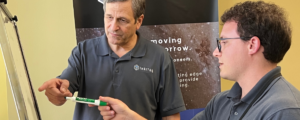Since those first microprocessor products first came out in the 1970s (calculators, microwave ovens, etc.) we have seen a rapid acceleration of technology in the workplace and in our homes. It’s a good bet that in your home today you have more computing power than NASA had to send astronauts to the Moon. We are in the middle of a ‘smart revolution’ that leaves many of us feeling a little dumb about how to understand and use all this smart technology.
The term “Smart” for technology actually started as an acronym – Self-Monitoring Analysis and Reporting Technology – but has evolved over the years to encompass any device with local computing power that can collect data, share the data with other devices, and then act on the data. Think about the first Apple ‘Smart phone’ where Apple created a phone that also had various sensors on it to know your location, the temperature, motion, and a camera and had the capability to share that information over a cellular network. Of course, when people got hold of the smartphone they immediately wondered “what else can I do this with it?” and next thing we know there are thousands of applications – apps – available to download to the phone. Now that phone becomes a node in a network of interconnected devices sharing data; the Internet of Things (IoT).

Think about all the devices we have today in our homes for security, convenience, and entertainment that are part of the IoT. We have video doorbells (Ring is a great example) that allow us to view who is at our homes no matter where we are. We have refrigerators that can tell us remotely their temperature and even give us a picture of what is inside as well as voice assistants (Alexa) that allow us to monitor and command devices in our homes such as lights, washers, and even EV chargers. Entertainment was the first way these devices got into our homes for gaming and now with streaming video. Nanowerk.com estimates that by 2030 there will be 15 devices connected to the internet for every person on the planet! How do we keep up with all this technology and not be overwhelmed by it?
Technology in business has changed the way we work and interact with our customers and colleagues. Just three years ago who would have predicted that a significant portion of our workforce would be working remotely using video conferencing, cloud-based shared data, and a host of other collaboration technologies? We see ‘smart technologies’ impacting major all sectors of our economy:
- Smart Factories with interconnected devices to control processes and share data with partners and customers anywhere in the world.
- Smart Logistics which allows tracking and tracing through the logistics chain, warehousing, and all the way to the end-user.
- Smart Agriculture using IoT sensors to gather data from the fields and allow farmers to be much more efficient to feed a growing population.
- Smart Healthcare with sharing of data across a network of providers and even telehealth to allow people in underserved rural areas to have access to specialists.
- Smart Cities using an IoT network of sensors and machines throughout a city’s infrastructure and services to develop, deploy, and promote sustainable development practices to address growing urbanization challenges.

So how do we navigate this bewildering sea of technology to make our businesses and communities “smart”? The answer lies in the main attribute that drives the smart revolution – connectivity – in this case connecting with knowledgeable people. With such a wide array of smart technology solutions, you need to have a network of trusted individuals to help you use these technologies to solve your real-world everyday problems. That’s where The Ginn Group comes in with our experts across facilities management, logistics, engineering, and information technology to help you identify and analyze your needs, then develop a set of solutions that balance technology and cost to best suit your business model.
The “smart” answer – The Ginn Group. Contact us today.








